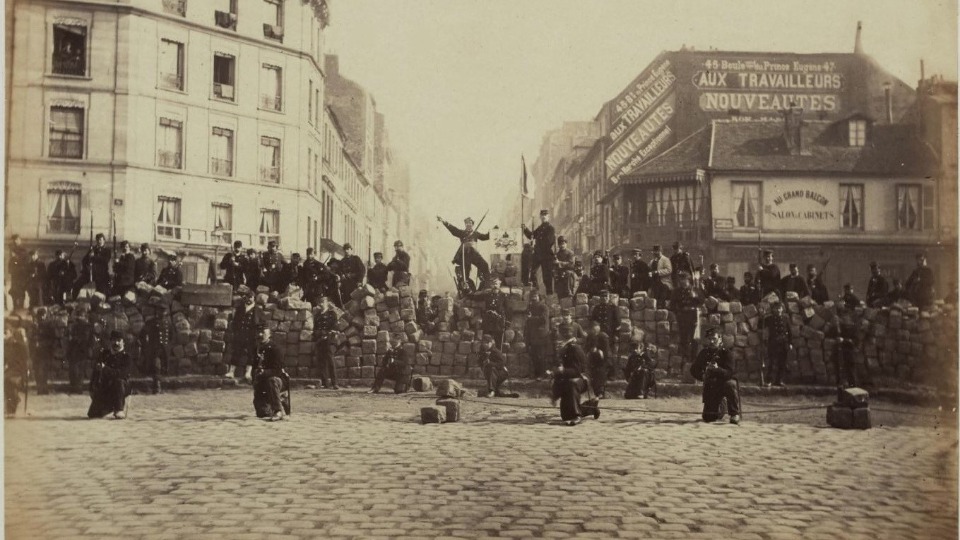
PARIS—Here in Paris, we are now living through the 150th anniversary of the Commune, identified by Karl Marx as perhaps the first worker’s republic established in the history of humanity. The commune lasted 71 days, beginning March 18, 1871, and ended in violent repression during what was called “the time of the cherries”—the budding of the cherry blossoms—in the bloody week of May 21 to 28.
The commune was a response by the Parisians to the end of a war the emperor Louis-Napoleon had waged to distract the French from the corruption and negligence that characterized the latter stage of his Second Empire. The ill-fated war ended up uniting the German states under Bismarck as the French military, also hollowed out by years of corruption, was quickly defeated.
The German army then became an occupying army and laid siege to Paris, figuring to starve the city into submission.
The French ruling class, industrialists, and remnants of the old aristocracy, led by the emperor’s minister Adolphe Thiers, left the city and fled to the former palace of the king at Versailles, where they would soon collaborate with the Germans to crush the Commune. Inside the city, a new form of government appeared, direct democracy with elements of the national guard on its side and with the working people of the city behind it, and engaged directly in carrying out reforms in health, education, and establishing an equal status for women. Indeed, the face of the Commune that has come down through history is that of the feminist Louise Michel, in the forefront of many of these reforms and, upon the downfall of the Commune, was exiled from France.
The Commune defied the industrialists and issued proclamation after proclamation that pushed the government of Paris toward a worker’s state. Thiers and the German collaborators he represented were furious and finally, with the aid of the German army, still encamped outside the city, moved to annihilate the rebellion, which he did in perhaps the bloodiest week of state terrorism in French history, other than the St. Bartholomew’s Day massacre of the Huguenots in 1572. Row after row of these working people were lined up and shot. The most sacred place commemorating the Commune is the Mur des Fédérés, the wall of these victims inside the famous cemetery Père Lachaise.
With the Commune in ruins, its proponents either dead or exiled, Thiers then proclaimed the birth of the French Republic, ending forever the attempts to re-establish the monarchy after it had originally been overthrown in the French Revolution.

Indeed, French Republicans now proclaim the Commune as a founding moment to establish a representative parliamentary democracy. However, that bourgeois democracy, with the industrialists now firmly back in power, was erected on the bones and coffins of the Parisian citizens who instead had instituted a direct democracy in which the people made decisions together.
Battles over the memory of the Commune continue to be waged. Adolphe Thiers is commemorated in the traditional French manner by having streets and squares named after him in many French cities and towns. However, no street or square bears his name in Paris, the site of his bloody executions.
The Catholic Church, attacked for its corruption by the Commune as it was in the French Revolution, allied with the state to anoint the Church of Sacre Coeur (Sacred Heart), which overlooks the city and stands as a symbol of the triumph of the bourgeoisie. However, just below the Church, in a way that suggests the old specter of revolution is not dead, sits Louise Michel square, with its commemoration of the Commune’s leading spirit.
Released to coincide with the 150th anniversary is La semaine sanglante (The Bloody Week), a work by the French historian Michèle Audin which claims that Thiers’s accounting of the dead is vastly understated. The official figure is over 6,000 casualties, but by checking cemetery records, this new book claims the figure is at least 15,000 and may have been as high as 20,000, with underground mass graves of the Communards still being discovered in the 1920s in the building of a line of the Paris Métro.

France celebrated the March 18th date with great fanfare. Still, that celebration quickly gave way to its opposite as the country readies itself for the 200th anniversary in May of the death of Napoleon, a symbol of empire and conquest beloved by the right and no friend of democracy, whose nephew, founder of the second empire named in honor of his uncle’s self-proclaimed first empire, started the war that brought on the siege of Paris.
Marx’s valuing of the experiment of the Commune, a spirit that is yet to be realized, points the way to why it remains at the same time a moment of hope for working people and a moment of fear for their new digital overlords, whether they be Jeff Bezos’s Amazon, Elon Musk’s Tesla, or Emmanuel Macron’s start-up nation:
“The value of these great social experiments cannot be overrated. By deed instead of by argument, they have shown that production on a large scale and in accord with the behests of modern science, may be carried on without the existence of a class of masters; that to bear fruit, the means of labor need not be monopolized as a means of dominion over, and of extortion against, the laboring man [and woman]…; and that, like slave labor, like serf labor, hired labor is but a transitory and inferior form, destined to disappear before associated [fédérés or communal] labor plying its toil with a willing hand, a ready mind, and a joyous heart.”
This website about the Mur des Fédérés has a host of information, resources, songs of the Commune, and photographs.
The Civil War in France: The Paris Commune, by Karl Marx and V.I. Lenin










